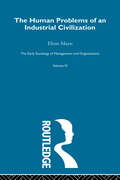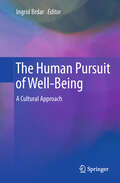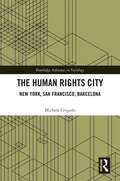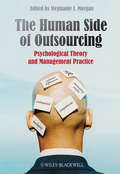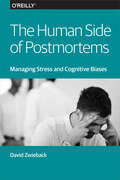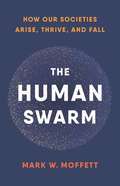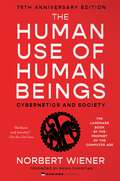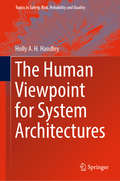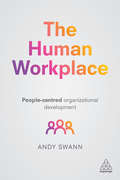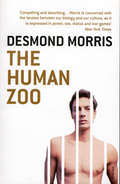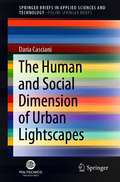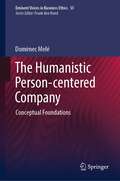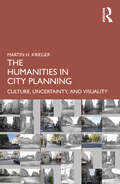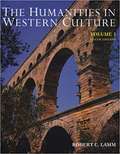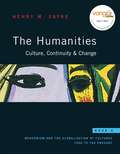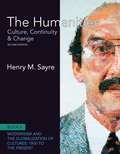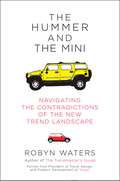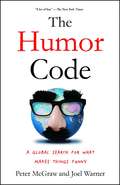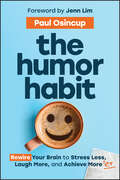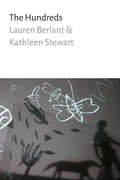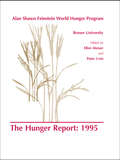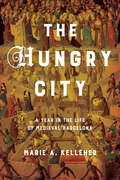- Table View
- List View
The Human Problems of an Industrial Civilization (Early Sociology Of Management And Organizations Ser.)
by Elton MayoIn this volume Mayo discusses the Hawthorne experiments, relating the findings about human relations within the Hawthorne plant to the social environment in the surrounding Chicago area. The Chicago School of Sociologists were studying aspects of social disorganization and this was a topic pioneered by Emile Durkheim.
The Human Pursuit of Well-Being
by Ingrid BrdarThis book brings together the latest research on positive psychology from an international cast of researchers and particularly from the growing body of European researchers. The chapters describe research and practice from diverse fields of positive psychology, covering topics such as happiness and well-being, motivation and goals, personality, academic performance and coping, measurement and interventions. The book emphasizes a cultural approach to the human pursuit of well-being. It is unique in that it presents research from a range of cultures, such as Russia, Croatia, and Egypt, in addition to ten different Western cultures. This approach helps broaden our understanding of those aspects of human experience that make life worth living in diverse cultural conditions. The book includes well-known and new authors from the field and contains selected papers that were presented at the 4th European Conference of Positive Psychology held in 2008 in Croatia.
The Human Rights City: New York, San Francisco, Barcelona (Routledge Advances in Sociology)
by Michele GrigoloWe are used to thinking of human rights as a matter for state governments to deal with. Much less investigated is the question of what cities do with them, even though urban communities and municipalities have been discussing human rights for quite some time. In this volume, Grigolo borrows the concept of ‘the human rights city’ to invite us to think about a new urban utopia: a place where human rights strive to guide urban life. By turning the question of the meaning and use of human rights in cities into the object of critical investigation, this book tracks the genesis, institutionalisation and implementation of human rights in cities, focussing on New York, San Francisco and Barcelona. Touching also upon matters such as women’s rights, LGBT rights and migrant rights, The Human Rights City emphasises how human rights can serve urban justice but also a neoliberal practice of the city. This book is a useful resource for scholars and students interested in fields such as Sociology of Human Rights, Sociology of Law, International Law, Urban Sociology, Political Sociology and Social Policies.
The Human Side of Outsourcing: Psychological Theory and Management Practice
by Stephanie J. MorganOutsourcing is now a strategic choice for many companies and a continuing issue for managers and consultants. The transfer, negotiation and ongoing management of outsourced contracts all demand a great deal of people management. Yet, while the implications for those directly affected may be numerous and wide-ranging, very little has been written on how to sensitively and successfully manage the transfer of such individuals – along with the emotional needs of those left behind. This book considers The Human Side of Outsourcing, integrating theory and practice to offer state-of-the-art advice for those responsible for implementation in the field along with insightful analysis for researchers and students of work psychology. Examining problems and solutions from employee and employer perspectives, Stephanie J. Morgan provides an in-depth study of the psychological theory, management practice and level and type of support required to engage staff and improve outcomes. Real-world case studies illustrate all the key issues involved, along with their implications for HR, line management, organizational performance and employees themselves.
The Human Side of Postmortems: Managing Stress And Cognitive Bias In Devops
by Dave ZwiebackImagine you had to write a postmortem containing statements like these?"We were unable to resolve the outage as quickly as we would have hoped because our decision making was impacted by extreme stress.""We spent two hours repeatedly applying the fix that worked during the previous outage, only to find out that it made no difference in this one.""We did not communicate openly about an escalating outage that was caused by our botched deployment because we thought we were about to lose our jobs."While the above scenarios are entirely realistic, it's hard to find many postmortem write-ups that even hint at these "human factors." Their absence is, in part, due to the social stigma associated with publicly acknowledging their contribution to outages. And yet, people dealing with outages are clearly subject to physical exhaustion and psychological stress, not to mention impaired reasoning due to a host of cognitive biases.This report focuses on the effects and mitigation of stress and cognitive biases during outages and postmortems. This "human postmortem" is as important as the technical one, as it enables building more resilient systems and teams, and ultimately reduces the duration and severity of outages.
The Human Swarm: How Our Societies Arise, Thrive, and Fall
by Mark W. MoffettThe epic story and ultimate big history of how human society evolved from intimate chimp communities into the sprawling civilizations of a world-dominating species <P><P>If a chimpanzee ventures into the territory of a different group, it will almost certainly be killed. But a New Yorker can fly to Los Angeles--or Borneo--with very little fear. <P><P>Psychologists have done little to explain this: for years, they have held that our biology puts a hard upper limit--about 150 people--on the size of our social groups. But human societies are in fact vastly larger. How do we manage--by and large--to get along with each other? <P><P>In this paradigm-shattering book, biologist Mark W. Moffett draws on findings in psychology, sociology and anthropology to explain the social adaptations that bind societies. He explores how the tension between identity and anonymity defines how societies develop, function, and fail. <P><P>Surpassing Guns, Germs, and Steel and Sapiens, The Human Swarm reveals how mankind created sprawling civilizations of unrivaled complexity--and what it will take to sustain them.
The Human Use of Human Beings: Cybernetics and Society
by Norbert WienerFor the 75th anniversary, a new edition of The Human Use of Human Beings—the landmark book that delves into the relationship between humans and computers, and presciently anticipates many contemporary dilemmas surrounding AI technology. With a new introduction by Brian Christian, author of the bestselling Algorithms to Live By and The Alignment Problem.In 1950, mathematician-philosopher Norbert Wiener ended this classic book on the place of machines in society with a warning: “We shall never receive the right answers to our questions unless we ask the right questions.... The hour is very late, and the choice of good and evil knocks at our door.”Wiener, the founder of the science of cybernetics—the study of the relationship between computers and the human nervous system—was widely mislabeled as an advocate for the automation of human life. As The Human Use for Human Beings reveals, his vision was much more complex and interesting, and is more relevant in today’s world of AI than anyone could have anticipated.In his new introduction, Brian Christian aptly calls Wiener the “progenitor of contemporary AI-safety discourse.” Wiener hoped that machines would release people from relentless and repetitive drudgery to achieve more creative pursuits, yet he anticipated the danger of dehumanizing and displacement. His pioneering views on the human-machine relationship as a “communicative process” are only more crucial now, as we carry in our pockets AI devices that we can literally speak to. His prescient warnings illuminate our contemporary relationships with language, art, and even social media.The Human Use of Human Beings examines the implications of cybernetics for education, law, language, science, technology, as Wiener anticipates the enormous impact—in effect, a third industrial revolution—that the computer has had on our lives.
The Human Viewpoint for System Architectures (Topics in Safety, Risk, Reliability and Quality #35)
by Holly A.H. HandleyThis book describes a methodology to represent socio-technical system concerns in the system architecting process. The resulting set of Human Views augments traditional system viewpoints with human-focused data. The Human Viewpoint methodology classifies the socio-technical system context, identifies and collects pertinent data, renders models that can be used for discussion and analysis, and presents the results in Fit for Purpose views that are useful for decision making. The inclusion of the Human Viewpoint during the system architecting stage allows the evaluation of human-system design trade-offs, recognises the impact of the human operator on system performance, and provides the foundation for Human System Integration evaluations during the ensuing system development.
The Human Workplace: People-Centred Organizational Development
by Andy SwannCompanies spend time and effort developing their employees - their most important asset - but they often forget to consider the company structure, culture, environment and processes required to help the newly upskilled individuals thrive. The Human Workplace is a practical guide which shows how this can be achieved by taking a truly people-centric approach to organizational development. Exploring how people-centred organizations behave and evolve, the book covers how to use design thinking to create optimal organizational structures, how to make a business a community, how to use communication to inform and empower people and how to use technology to allow employees to work more efficiently.Packed with interviews and case studies from Microsoft, Schneider Electric, CGI, Universal, Lego, SAP, BBC Worldwide and other global companies that have benefited from a people-centred approach, The Human Workplace redefines our view of the organization, its relationship with people and how we interact with it. It is an essential guide for all HR and OD professionals seeking to get the right people in the right places doing the right things at the right time.
The Human Zoo
by Desmond MorrisA must-read for anyone who has ever wondered why people do what they do, from the popular author of The Naked Ape.This study concerns the city dweller. Morris finds remarkable similarities with captive zoo animals and looks closely at the aggressive, sexual and parental behaviour of the human species under the stresses and pressures of urban living.‘Compelling and absorbing...Morris is concerned with the tension between our biology and our culture, as it is expressed in power, sex, status and war games’ New York Times
The Human and Social Dimension of Urban Lightscapes (SpringerBriefs in Applied Sciences and Technology)
by Daria CascianiThis book explores new criteria and characteristics for integrating human psychology in the design of modern urban lighting. It identifies a new area of lighting design research and practice that focuses on the nocturnal urban experience in terms of people’s emotional, cognitive and motivational perceptions to achieve more accessible, sociable and sustainable cities. In turn, the book compares new tools and research methodologies for tackling complex issues concerning the ties between lighting, people and the city. Moreover, it presents a series of case studies to provide an in-depth understanding of the influence of urban lighting in terms of luminous atmosphere perception, positive social affect, social enhancement, accessibility and hospitability. Lastly, the book proposes a multidisciplinary qualitative and quantitative methodology for assessing the spatial experience of outdoor lighting.
The Humanistic Person-centered Company (Issues in Business Ethics #55)
by Domènec MeléHumanism in business is not only an alternative to economism but a way to human excellence. Humanism presented here revolves around the rich notion of “human person”, keystone of modern personalist philosophy and Catholic Social Teaching. From this perspective this book is offered to everyone, believer and nonbeliever alike. The person-centered humanism considers the human-wholeness, individual and relational, with subjectivity, self-determination, openness to transcendence, and with capacity not only to possess but also to give. It also highlights the uniqueness of each person, endowed with a high constitutive dignity and in continuous process of flourishing toward human plenitude. An attitude of respect and good will is due to non-personal beings, while persons deserve to be treated with justice and even with love of benevolence. The book is prepared in dialogue with mainstream of thought in business and business ethics and focused on exploring ways to improve some conventional views. It includes some proposals such as a person-based ethics, ethics understood as intrinsic to business activity, the consideration of the company as an organized community of persons, and the purpose of the company oriented toward the common good through a double mission, internal and external. It is also suggested substituting the notion of “stakeholder” for the richer one of “relationholder.”
The Humanities "crisis" And The Future Of Literary Studies
by Paul JayDemonstrating that the supposed drawbacks of the humanities are in fact their source of practical value, Jay explores current debates about the role of the humanities in higher education, puts them in historical context, and offers humanists and their supporters concrete ways to explain the practical value of a contemporary humanities education.
The Humanities in City Planning: Culture, Uncertainty, and Visuality
by Martin KriegerThis book by preeminent planning theorist Martin H. Krieger explores how cities are much more than their economies, demographies, or geographies. Planning today is dominated by social science, but Kreiger takes a different approach, thinking of city planning in terms of Culture, Uncertainty, and Visuality. The chapters explore planners and their role as protagonist in the humanities of literature and history; the inevitability of uncertainty in planning and how to face it; and how to attend to the physical, visual, and aural environment of the city. Through a series of essays, Krieger shows that cities are cultural and meaningful, that they are contingent and so filled with opportunity, and that they are concrete, particular, and encountered. The Humanities in City Planning will be of interest to students and scholars of the humanities and planning looking for alternative ways of viewing the city.
The Humanities in Western Culture: A Search For Human Values
by Robert LammThese two beautifully illustrated chronological volumes introduce your students to the arts of literature, sculpture, painting, architecture, music, photography, and film, and the philosophical ideas permeating ancient through modern civilizations. Packaged with supplemental Student Study Guides and audio cassettes to accompany each volume, this set provides an excellent all-in-one introduction to the humanities.
The Humanities: Modernism and the Globalization of Cultures, 1900 to the Present
by Henry M. SayreThe Humanities by Henry M. Sayre helps the reader see the context and make the connections across the humanities by tying together the entire cultural experience through a narrative storytelling approach.
The Humanities: Modernism and the Globalization of Cultures, 1900 to the Present (2nd Edition)
by Henry M. SayreThe Humanities by Henry M. Sayre helps the reader see the context and make the connections across the humanities by tying together the entire cultural experience through a narrative storytelling approach. For an undergraduate introductory level course in the humanities.
The Humans
by Stephen Karam"A kind, warm, beautifully observed and deeply moving new play, a celebration of working-class familial imperfection and affection and a game-changing work for this gifted young playwright."-Chicago Tribune"Karam is in rare form here, showing a remarkable ear for the way families converse... For all the characters' woes, this is a warm, funny, sharply observed portrait of their abiding connections with one another." -Time Out ChicagoBreaking with tradition, Erik Blake has brought his Pennsylvania family to celebrate Thanksgiving at his daughter's apartment in lower Manhattan. Unfolding over a single scene, this "delirious tragicomedy" (Chicago Sun-Times) by acclaimed young playwright Stephen Karam "infuses the traditional kitchen-sink family drama with qualities of horror in his portentous and penetrating work of psychological unease" (Variety), creating an indelible family portrait.Stephen Karam's plays include Speech & Debate and Sons of the Prophet, a finalist for the 2012 Pulitzer Prize and the winner of the 2012 Drama Critics Circle, Outer Critics Circle, Lucille Lortel and Hull-Warriner awards for Best Play. Born and raised in Scranton, PA, he lives in New York City.
The Hummer and the Mini: Navigating the Contradictions of the New Trend Landscape
by Robyn WatersFrom the former trendmaster of Target--how the power of contradictory trends can help reframe your business strategy Contradictions are everywhere! These days we wear Old Navy with new Gucci, Hanes T-shirts with Armani suits, couture Chanel with vintage denim. Suburban mansions are filled with flea market finds, and we show off our Michael Graves teakettle from Target on Viking stoves in our gourmet kitchens that might even include cabinets purchased from IKEA. When Robyn Waters began her career in the late 1970s, a trend was defined as something that everyone wanted at the same time. Fashion and business magazines proclaimed what was "in" and what was "out." Back then, it was fairly easy for companies to determine the next big trend, and ride it all the way to the bank. In today's marketplace the "next big thing" has been replaced by a thousand next big things. And in order to discover what consumers are hungry for companies need to discover what's important...to them. Today a cookie cutter approach no longer works. Waters explains that for every trend there's an equally valid countertrend. In The Hummer and the Mini, Waters explores the new trend landscape and urges companies to stop looking for the one right answer in their industry. There are many good ways to design products, develop a line of goods, merchandise a store, or craft a marketing message. You can thrive by selling huge cars (the Hummer) or tiny ones (the Mini). You can turn something old into something new and desirable (the Vespa) or turn a commodity into a luxury (In-and-Out Burgers at the Oscars). You can even customize a product designed for the masses (personalized postage stamps) or sell less as more (Minute Clinics). Through lively tales of influential trends and countertrends, The Hummer and the Mini will show you how to live with the contradictions, make the most of the inconsistencies, and embrace the paradoxes of business as a source of fresh ideas.
The Humor Code: A Global Search for What Makes Things Funny
by Joel Warner Peter McGrawPart road-trip comedy and part social science experiment, a scientist and a journalist “shed fascinating light on what makes us laugh and why” (New York Post).Two guys. Nineteen experiments. Five continents. 91,000 miles. The Humor Code follows the madcap adventures and oddball experiments of Professor Peter McGraw and writer Joel Warner as they discover the secret behind what makes things funny. In their search, they interview countless comics, from Doug Stanhope to Louis CK and travel across the globe from Norway to New York, from Palestine to the Amazon. It’s an epic quest, both brainy and harebrained, that culminates at the world’s largest comedy festival where the pair put their hard-earned knowledge to the test. For the first time, they have established a comprehensive theory that answers the question “what makes things funny?” Based on original research from the Humor Research Lab (HuRL) at the University of Colorado, Boulder, and the pair’s experiences across the globe, The Humor Code explains the secret behind winning the New Yorker cartoon caption contest, why some dead baby jokes are funnier than others, and whether laughter really is the best medicine. Hilarious, surprising, and sometimes even touching, The Humor Code “lays out a convincing theory about how humor works, and why it’s an essential survival mechanism” (Mother Jones).
The Humor Habit: Rewire Your Brain to Stress Less, Laugh More, and Achieve More'er
by Paul OsincupDiscover and embrace the untapped power of your sense of humor In The Humor Habit: Rewire Your Brain to Stress Less, Laugh More, and Achieve More’er, veteran speaker, corporate trainer, and comedian Paul Osincup delivers a hilarious and effective new take on how to make yourself and your team more productive and resilient by focusing on the funny side of work and life. In the book, you’ll learn why humor isn’t an in-born quality you’re either born with or without. Instead, it’s a habit you can develop over time. You’ll find 100 ways to have more fun at work, methods to improve your resilience in dealing with adversity, and an explanation of the author’s “LAFTER” model that shows you how to leverage levity at work. You’ll also discover: The latest insights from contemporary positive psychology combined with timeless comedic techniques that enhance your wellbeing Strategies to help you battle “chronic seriousness,” a condition affecting virtually every professional, tradesperson, consultant, employee, manager, and business leader in the working world Ways to boost your team members’ brainpower and productivity using humorPerfect for managers, executives, team leads, directors, and other business leaders, The Humor Habit is the practical, hands-on guide to improved productivity that’s actually fun to read—and even more fun to implement.
The Hundreds
by Kathleen Stewart Lauren BerlantIn The Hundreds Lauren Berlant and Kathleen Stewart speculate on writing, affect, politics, and attention to processes of world-making. The experiment of the one hundred word constraint—each piece is one hundred or multiples of one hundred words long—amplifies the resonance of things that are happening in atmospheres, rhythms of encounter, and scenes that shift the social and conceptual ground. What's an encounter with anything once it's seen as an incitement to composition? What's a concept or a theory if they're no longer seen as a truth effect, but a training in absorption, attention, and framing? The Hundreds includes four indexes in which Andrew Causey, Susan Lepselter, Fred Moten, and Stephen Muecke each respond with their own compositional, conceptual, and formal staging of the worlds of the book.
The Hunger Report 1995: The Alan Shawn Feinstein World Hunger Program, Brown University, Providence, Rhode Island
by Ellen Messer Peter UvinThe Hunger Report 1995 highlights progress during the past five years on the problems of food shortage, poverty-related hunger, maternal-child nutrition and health, and micronutrient malnutrition. It is constructed from papers and discussions presented at the five-year-follow-up to the Bellagio Declaration, 'Overcoming Hunger in the 1990s' (1989). Individual essays by hunger researchers, monitors, and policy makers assess advances in achieving the Bellagio goals, which are: 1) to end famine deaths, especially by moving food into zones of armed conflict; 2) to end hunger in half the world's poorest households; 3) to eliminate at least half the hunger of women and children by expanding maternal-child health coverage; and 4) to eliminate vitamin A and iodine deficiencies as public health problems.
The Hungry City: A Year in the Life of Medieval Barcelona (Medieval Societies, Religions, and Cultures)
by Marie A. KelleherThe Hungry City is the story of medieval Barcelona, retold through the lens of food and famine. Between the summer of 1333 and the spring of 1334, severe weather-related grain shortages spread throughout the Mediterranean, and Barcelona's leaders struggled to bring food to the city as its residents grew increasingly desperate. Employing the perspectives of historical actors whose stories are drawn from the records of that catastrophic year, Marie A. Kelleher uses Barcelonans' varied responses to crisis in the food system to present multiple ways of understanding the city—as a physical space, as the center of a network of Mediterranean commerce, as one powerful entity within a broader monarchy, as a site of religious encounter, and as a complex social body. Even as the central figure in each chapter offers their own version of the city, the separate strands of these multiple Barcelonas intertwine to reveal the fabric of the city as a whole.The medieval city was defined by its network of human relationships—between its rulers and ruled; its merchants, artisans, and laborers; its religious and secular authorities; its insider and outsider groups—and by its overlapping local and regional geographies. Barcelona in the fourteenth century was no different, and The Hungry City draws together multiple lives and narrative strands to focus on a single point in time, what one Catalan chronicler referred to as "the first bad year," providing a dynamic new perspective on the history of Barcelona and the medieval Mediterranean.
The Hungry Mind
by Susan EngelDespite American education's mania for standardized tests, testing misses what matters most about learning: the desire to learn in the first place. Susan Engel offers a highly readable exploration of what curiosity is, how it can be measured, how it develops in childhood, and how educators can put curiosity at the center of the classroom.
